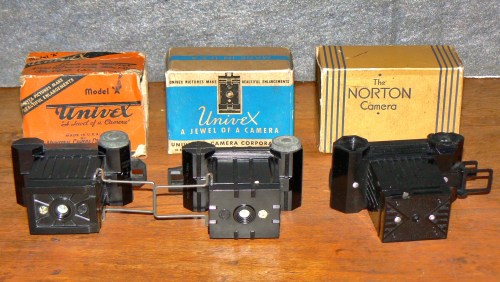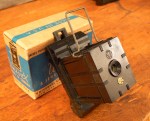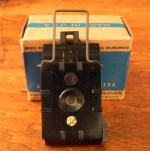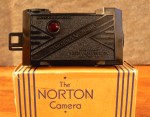
The first molded plastic cameras came out in 1933-34
Early History of the Universal Camera Company (UniveX)
In 1933, at the height of the Great Depression, two men in the taxicab business decided to start a camera company. Otto Githens was an executive for a loan company that specialized in financing taxicab operations. His new partner, Jacob Shapiro, was an agent for a taxicab insurance underwriter. Between the two of them, they had a total of zero years of experience in the camera business, yet they were enthusiastic about their ability to take on Eastman Kodak in the amateur photography market. They had ideas about how to achieve their goal, and some of these ideas were scoffed at by Kodak and Ansco, the two American companies who currently controlled the market. First off, they planned to produce and sell a camera for the paltry sum of 39 cents. At this rate, anyone who really wanted a camera could afford to buy one. The second step of their plan involved the film for the camera. They contracted Gevaert of Belgium to produce a proprietary rollfilm which would sell for 10 cents. Each roll would provide six exposures, and their camera would only accept this film. These non-standard film formats were essential to their business plan, since they could give cameras away if necessary, and still make money on the film. The final step in their plan followed directly from step 2: they would set up processing labs across the country to develop the non-standard film, thus insuring control of the entire supply chain.
They did in fact put their plan into action, and in 1934, they sold 2.6 million of their little molded Bakelite cameras. Needless to say, they also sold millions of rolls of film, and they also processed that film. In a few years they would be able to boast that they sold more cameras per year than any company in the world.
If the years 1933 and 1934 heralded the start of the Universal Camera Company, they also heralded the beginning of a reputation that would follow the company throughout its history. It seems that, while investigating how to produce their popular little camera, they spoke extensively to Norton Labs in New York about designing and producing their camera for them. There seems to be some doubt about what was said and agreed upon, but what is known is that when the UniveX Model A hit the market, the boys at Norton Labs were dismayed. They had gone ahead with the camera design and even made molding dies, believing that they had a production contract with Universal
- The first molded plastic cameras came out in 1933-34
- Model A Sunburst (second version of 1933)
- Front View
- Back View
- Model A Geometric Design of 1934
- Front View
- The original Norton Camera
- Norton Back View
. The camera looked amazingly like the UniveX Model A. Patents were applied for by both companies. An “interference” was adjudged, and a hearing was held. The courts eventually found in favor of Universal, and the UniveX camera remained on the market. In fact, Universal eventually bought Norton Labs out, rebadging the Norton Camera as the “Norton-UniveX.” Many critics of the Universal Camera Company believed that they had simply stolen Norton’s design, beaten them to market, and bullied their way through the courts on the strength of their position in the marketplace. True or not, they did accomplish one thing that proved to be good for the photographic industry: they made the camera affordable. Within a few years, Kodak, Ansco, Argus, and many others were selling molded plastic cameras in order to compete in the amateur photography market. Universal was the reason for all of it.
Facts for the Collector
The Univex Model A began as an all-plastic camera with an imported glass meniscus lens and a single speed metal shutter. The front of the camera bore a sunburst design, the lens opening was plain and unadorned, and the wind knob was plastic. This version was made only in 1933, and is very rare. I don’t own one, and I’ve only seen them in pictures.
The second 1933 model also bore the sunburst design, but the following design changes are evident: first, the lens opening is stepped, to reduce stray light reflections; second, the wind knob is made of die-cast zinc rather than plastic.
Photos below depict the second 1933 sunburst model, the 1934 geometric design, and the original Norton Camera design that was the center of so much litigation. These little cameras still show up in flea markets, yard sales, and antique shops from time to time. They are omnipresent on Ebay, although they are often misrepresented as “rare.” Considering that about 3 million were made by the end of 1934, it’s not surprising that they’re still out there.









I have what I beleive to be a 1934 Univex model A camera. It has a partial original box/with a direction sheet. As you are looking at the front lens area, the wind knob is on the bottom right at the rear. It is a metal knob. It is not the starburst design. Is it possibly of any value? Thanks for your help.
William:
You have the geometric design Univex Model A, which was produced starting in 1934, and was sold as a cereal-box premium for many years thereafter, even post WWII. These cameras have sold on ebay in the past 30 days for prices ranging from $9.95 to $21.00. Thanks for visiting the blog! Dana
I have a Univex Mercury Rapid Winder in the original box that looks like new. Can you tell me how much it is worth and where I might sell it?
Do you have any information on a Universal Camera a “Minute 16″? It is roughly 2 3/4 ” X 1 3/4 ” X 1 “, Metal casing, ranging 6.3, 8, 11,16 on the Lens Aperture lever.
I have two of the Model A cameras one in the box with the instructions and one not in the box.and both have the metal nobs. Just for fun.
I have “GRAMPA’s” UniveX 8mm Projector, Model PU-8: Variable Speed Control, 50 watt motor & 150 watt bulb (both working), front leveling foot. This unit is in working order yet needs TLC, oiling & possibly replaced drive springs. What would be a ‘reasonable’ asking price & is there a possible market? As a child in ’40’s & ’50’s, I remember my Grandfather showing early Home Movies (I’m keeping) at family gatherings.
I used mine for taking long exposures by drilling a small hole and inserting a pin to keep the shutter open-about year 1941.
I have univex Norton camera/in box camera looks new but box is very torn!
When I was a teenager, along with two friends, we attempted to produce a movie. We used a borrowed Univex 8mm movie camera. Unfortunately, something went wrong and all we had was one very small black rectangle.
The film never moved thru the camera.
I have the early ’33 model. it’s the only one I have been lucky enough to find. Very rare indeed.
I just sold my 1948 Mercury Meteor for $35.00, after buying it in a Brooklyn pawn shop for about $20. in the late 50s’. Camera stores could no longer print from half-frame negatives, so I had the film developed, mounted each image in its’ own slide mount, then ran the mounts through my scanner, and adjusted the jpeg images to any size I wanted. I sold my last box of Mercury slide mounts with the camera, knowing rthet are probably impossible to find these days.
What are the characteristics of the Univex film itself? Even though it was a proprietary film in its day, would it be processible by any of today’s chemistries? I just acquired a geometric design model at an antique store which had a full roll of film already exposed…
Pingback: 相机的瑰宝:UniveX的阴暗起源 – 毒镜头